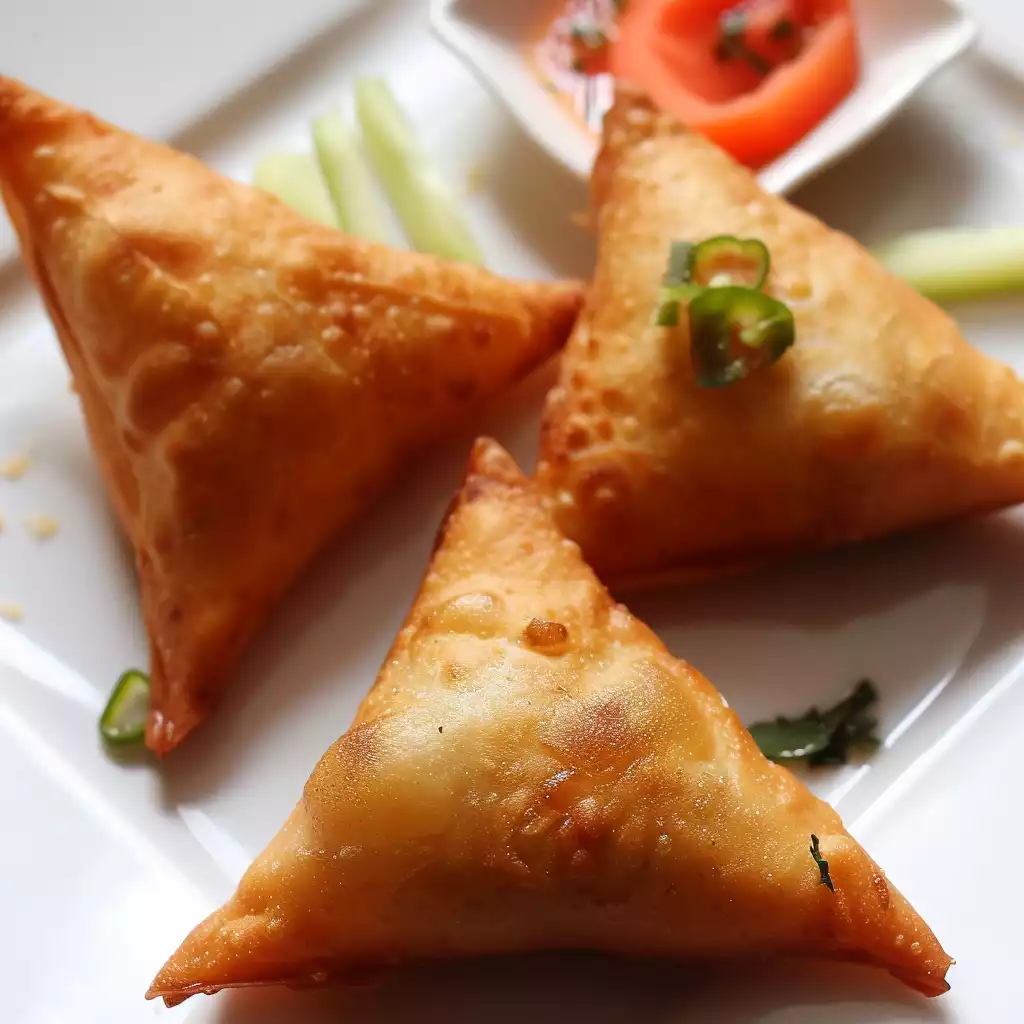
Vegetable Samosa, a delectable and savory treat that has captured the hearts and taste buds of food enthusiasts around the world. This mouthwatering snack, with its crispy golden exterior and flavorful filling, is a true delight for both vegetarians and non-vegetarians alike.
But have you ever wondered about the fascinating history behind this beloved recipe?
Originating from the Indian subcontinent, the samosa has a rich culinary heritage that dates back centuries. Its roots can be traced to the Middle East, where it was introduced by traders and travelers who traversed the ancient Silk Road.
Over time, this delectable dish made its way to the Indian subcontinent, where it underwent a delightful transformation, incorporating local flavors and ingredients.
The samosa’s popularity quickly spread throughout the region, becoming an integral part of Indian, Pakistani, and Bangladeshi cuisine. Today, it is not only a staple street food in these countries but also a cherished item on restaurant menus worldwide. Its versatility and adaptability have made it a beloved snack that transcends borders and cultures.
Now, let’s dive into the delightful process of making vegetable samosas. While it may seem daunting at first, fear not! With a little practice and patience, you’ll be able to master this culinary art. The recipe difficulty can be considered moderate, as it requires some skill in folding the dough and sealing the samosas. However, don’t let that deter you from embarking on this flavorful journey.
The key to achieving the perfect samosa lies in the balance of textures and flavors. The outer pastry should be crispy and flaky, while the filling should be a harmonious blend of aromatic spices and a medley of vegetables. From potatoes and peas to carrots and onions, the options for fillings are endless, allowing you to customize your samosas to suit your taste preferences.
Whether you’re hosting a gathering, craving a delicious snack, or simply looking to explore the wonders of Indian cuisine, vegetable samosas are a delightful choice that will leave you craving for more. So, roll up your sleeves, gather your ingredients, and get ready to embark on a culinary adventure that will transport you to the vibrant streets of the Indian subcontinent.
Plain Flour: Plain flour, also known as all-purpose flour, is a versatile ingredient commonly used in baking and cooking. It is made from wheat and has a moderate protein content. In this recipe, plain flour is used to make the dough for the samosa pastry.
Vegetable Oil: Vegetable oil is a cooking oil derived from various plants. It is used in this recipe for frying the samosas, giving them a crispy and golden exterior.
Salt: Salt is a crucial ingredient that enhances the flavor of dishes. It adds a savory taste to the samosa filling and balances the other spices used in the recipe.
Ajwain Seeds: Ajwain seeds, also known as carom seeds, have a strong aroma and a slightly bitter taste. They are commonly used in Indian cuisine for their digestive properties and unique flavor. Ajwain seeds add a distinct taste to the samosa filling.
Potatoes: Potatoes are starchy root vegetables that are widely used in cooking. They provide a creamy texture and mild flavor to the samosa filling. Potatoes also act as a binding agent, helping to hold the filling together.
Carrots: Carrots are root vegetables known for their vibrant orange color and sweet taste. In this recipe, they add a hint of natural sweetness and contribute to the overall flavor and texture of the samosa filling.
Peas: Peas are small, round green vegetables that are often used in various dishes. They add a pop of color, texture, and a slightly sweet taste to the samosa filling.
Cumin Seeds: Cumin seeds are aromatic seeds with a warm and earthy flavor. They are widely used in Indian cuisine and provide a distinct taste to the samosa filling.
Coriander Powder: Coriander powder is made from ground coriander seeds. It has a mild, slightly citrusy flavor and is commonly used as a spice in Indian cooking. Coriander powder adds a subtle yet essential taste to the samosa filling.
Garam Masala: Garam masala is a blend of ground spices commonly used in Indian cuisine. It typically includes spices like cumin, coriander, cinnamon, cloves, and cardamom. Garam masala adds a rich and aromatic flavor to the samosa filling.
Red Chilli Powder: Red chilli powder is made from dried and ground red chili peppers. It adds heat and a vibrant red color to the samosa filling. The amount used can be adjusted according to personal preference for spiciness.
Turmeric Powder: Turmeric powder is a bright yellow spice commonly used in Indian cooking. It has a warm and slightly bitter flavor. Turmeric powder not only adds color to the samosa filling but also provides a subtle earthy taste.
Vegetable samosas are a delicious and versatile dish that can be served as an appetizer, snack, or even as part of a main course. Here are some serving suggestions and pairings to enhance the flavors and create a well-rounded meal:
With these serving suggestions and pairings, you can create a delightful Indian-inspired meal featuring vegetable samosas. Whether you’re hosting a gathering or simply enjoying a cozy night in, these accompaniments will enhance the flavors and provide a well-rounded dining experience.
A Vegetable Samosa is a popular Indian snack that consists of a crispy, deep-fried pastry filled with a savory mixture of spiced vegetables. It is often served with chutney or sauce.
The main ingredients used in Vegetable Samosa include potatoes, peas, onions, carrots, spices (such as cumin, coriander, turmeric, and garam masala), and a pastry dough made from all-purpose flour.
Yes, Vegetable Samosas are typically vegan as they do not contain any animal products. However, it is always advisable to check the ingredients or ask the vendor to ensure there are no dairy or animal-based ingredients added.
Vegetable Samosas are commonly served as an appetizer or snack. They are often accompanied by various chutneys or sauces, such as mint chutney, tamarind chutney, or tomato sauce, to enhance their flavor.
Yes, if you prefer a healthier alternative, you can bake Vegetable Samosas instead of deep-frying them. Simply brush the samosas with oil and bake them in a preheated oven at around 375°F (190°C) until they turn golden brown and crispy.
Traditional Vegetable Samosas are not gluten-free as the pastry dough contains all-purpose flour, which is not gluten-free. However, you may find gluten-free versions of samosas made with alternative flours, such as chickpea flour or rice flour.
Yes, you can freeze Vegetable Samosas for later consumption. After preparing and shaping the samosas, place them on a baking sheet lined with parchment paper and freeze until firm. Then, transfer them to an airtight container or freezer bag and store in the freezer for up to 3 months. When ready to eat, deep-fry or bake them directly from frozen until heated through.
To reheat leftover Vegetable Samosas, preheat your oven to 350°F (175°C). Place the samosas on a baking sheet and bake for about 10-15 minutes or until they are heated through and crispy. Alternatively, you can also reheat them in a microwave for a shorter duration, but this may result in a slightly softer texture.
Here are some more recipes for you to enjoy! If you my recipes don’t forget to rate and leave a comment.
If you have any recipe suggestions, please do not hesitate to ask me. A great way to stay in contact with me is through Instagram, Facebook, Twitter and YouTube. Don’t forget to tag me @CookwithNabeela in your recipe photos!

Subscribe now to receive my latest recipes directly in your inbox. Stay up-to-date and never miss out!

I love to cook! I want to share with you my favourite, delicious family-friendly recipes. I want to inspire you to create fantastic food for your family every day.
Add your first comment to this post